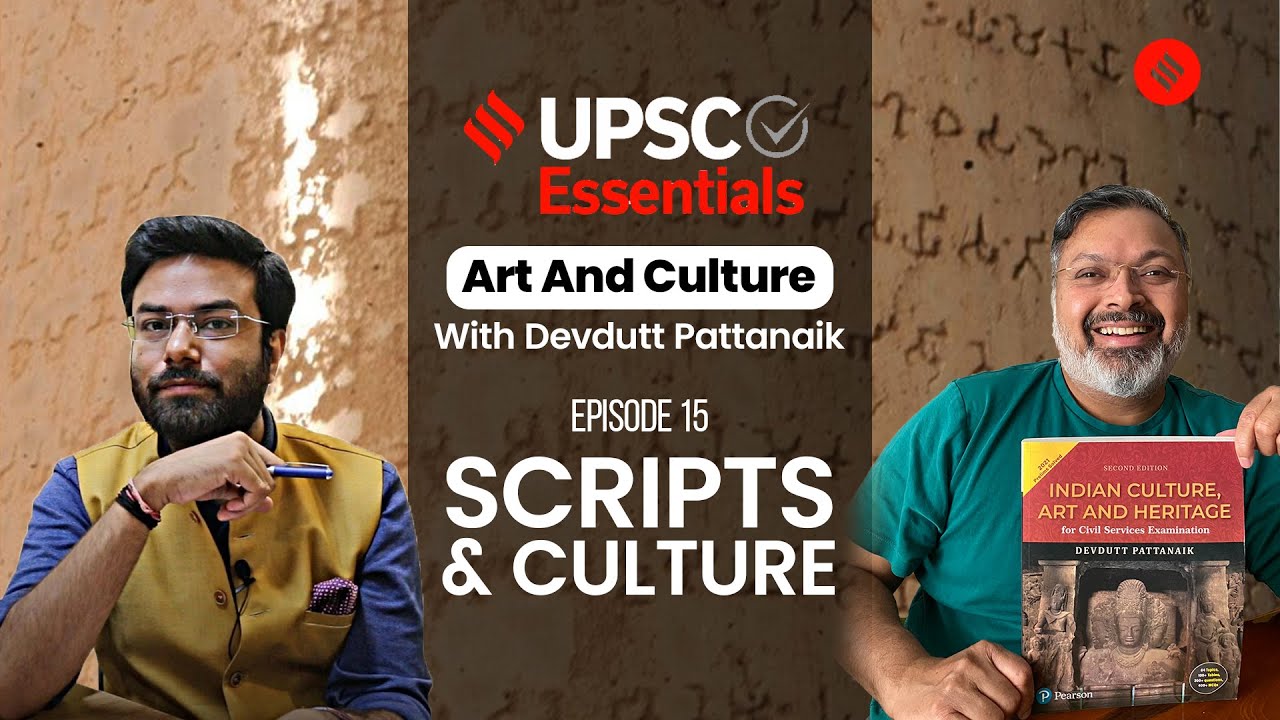Writing Materials In India: Know In Art & Culture With Devdutt Pattanaik EP16 | UPSC Essentials
Summary
TLDRIn this episode of 'Art and Culture with Devdutt Patnaik,' the discussion delves into the evolution of writing materials in India, from early Harappan clay tablets to the use of bhojapatra and palm leaves. The influence of these materials on script styles, such as the angularity of North Indian scripts versus the rounded nature of South Indian ones, is highlighted. The script also touches on the pothi manuscript culture and the impact of paper's introduction on documentation. Furthermore, it explores the National Language Translation Mission's 'Bhashini' platform, which utilizes AI for translation services, and the importance of preserving India's linguistic diversity, with the acknowledgment of over 19,500 distinct languages and dialects.
Takeaways
- 📜 The earliest scripts in India were written on soft stones and clay tablets, with later transitions to more durable materials like stone tablets and metal plates.
- 🌳 Perishable materials like cloth were used for writing, but leaves and plant parts, such as birch bark (bhojapatra) in North India and palm leaves in South India, were more common due to cultural preferences.
- ✍️ The angularity of North Indian scripts like Sharada, Devanagari, and Siddham is attributed to the use of durable materials and writing tools that allowed for straight lines, whereas South Indian scripts evolved to be more rounded due to the use of palm leaves and styluses.
- 🎨 The pothi manuscript culture involved binding together leaves or bark with a stylus-carved writing and ink powder, wrapped in cloth, and was significant in traditional Indian documentation.
- 📚 The introduction of paper to India, facilitated by trade with China and later the Muslim rule, revolutionized documentation and communication, with paper manufacturing becoming prominent by the 15th century.
- 🏭 The establishment of paper factories in India was influenced by the arrival of the Turco-Afghan rulers and later the British, who introduced mechanized paper production.
- 🤖 Bhashini, part of the National Language Translation Mission, is an AI-powered platform developed by the Government of India that provides translation services and can transform speech into text across multiple languages.
- 🌐 Bhashini includes a crowdsourcing component called Bashadhan, which allows public participation in language translation and validation, similar to the model used by Wikipedia.
- 🗣️ The loss of languages in India is a significant concern, with approximately 250 languages lost in the last 60 years and predictions of another 150 disappearing in the next 50 years.
- 🛡️ Efforts to document and preserve local and dying languages are crucial to maintaining cultural diversity and the unique perspectives each language offers on the world.
- 🔗 The discussion emphasizes the importance of connecting cultural topics with governance, policy, and technology to gain a comprehensive understanding and prepare effectively for examinations.
Q & A
What is the main difference between North Indian and South Indian scripts in terms of their appearance?
-North Indian scripts, such as Sharada and Devanagari, have angular and straight vertical and horizontal lines, while South Indian scripts are more rounded and resemble squiggles, lacking the straight lines due to the use of palm leaves as writing material.
What were the early writing materials used in India?
-The earliest Harappan scripts were written on soft stones and clay tablets. Later, in North India, materials like stone tablets, metal plates, and perishable materials such as cloth were used. However, the most common materials were leaves and parts of plants, specifically birch bark (Bhojapatra) in North India and palm leaves in South India.
Why were leaves and plant parts preferred over leather for writing in ancient India?
-In ancient India, leather was considered inauspicious, so people preferred plant products for writing. This led to the use of materials like birch bark and palm leaves.
How did the introduction of paper impact documentation and communication in India?
-The introduction of paper, which came to India after the 12th century with the arrival of Muslims, greatly impacted documentation and communication by providing a more durable and accessible writing material. It led to the establishment of paper factories and the mechanization of paper production in the 15th and 18th centuries, respectively.
What is the 'Pothi manuscript culture' mentioned in the script?
-The Pothi manuscript culture refers to the traditional method of creating manuscripts in India using birch bark or palm leaves. These leaves were written on with a stylus and ink powder, then bound together with a punch mark and wrapped in a colored cloth called a rumal.
How did the rulers of the 12th and 13th centuries influence the creation of manuscripts and paintings in India?
-During the rule of the Turko-Afghan Kings who followed Islam, the construction of temples was restricted. This led to an increase in the production of manuscripts and paintings, which were encouraged as an alternative form of cultural expression.
What is Bhashini, and how does it function?
-Bhashini is an AI-powered platform developed by the Government of India as part of the National Language Translation Mission. It performs translation services, transforming speech into text in multiple languages, translating the text, and then converting it back into speech. It also includes optical character recognition and crowd-sourcing through a project called Bashadhan.
What is the significance of the term 'Bashadhan' in the context of Bhashini?
-Bashadhan is the crowd-sourcing arm of Bhashini, which encourages public participation in the translation and validation process. It includes activities like listening to and transcribing speech (Suno India), speaking out given text (Bolo India), writing out what is heard (Liko India), and validating translations and transcriptions (Tyagoo India).
How many languages are spoken in India, and what is the status of language diversity in the country?
-India is home to about 121 languages spoken by more than 10,000 people each, covering around 1.2 crore people. However, when considering mother tongues and dialects, the number exceeds 19,500. The government officially recognizes 22 scheduled languages and has identified several classical languages.
What are the implications of language extinction, and what efforts are being made to preserve them?
-Language extinction leads to the loss of unique cultural perspectives and knowledge. In the past 60 years, India has lost about 250 languages, and it is estimated that another 150 may disappear in the next 50 years. Efforts to document and record these languages, including oral-only languages, are being made to ensure their survival, with projects like Bhashini potentially playing a crucial role.
Outlines

هذا القسم متوفر فقط للمشتركين. يرجى الترقية للوصول إلى هذه الميزة.
قم بالترقية الآنMindmap

هذا القسم متوفر فقط للمشتركين. يرجى الترقية للوصول إلى هذه الميزة.
قم بالترقية الآنKeywords

هذا القسم متوفر فقط للمشتركين. يرجى الترقية للوصول إلى هذه الميزة.
قم بالترقية الآنHighlights

هذا القسم متوفر فقط للمشتركين. يرجى الترقية للوصول إلى هذه الميزة.
قم بالترقية الآنTranscripts

هذا القسم متوفر فقط للمشتركين. يرجى الترقية للوصول إلى هذه الميزة.
قم بالترقية الآنتصفح المزيد من مقاطع الفيديو ذات الصلة

Understanding Language & Scripts: Art & Culture with Devdutt Pattanaik EP13 | UPSC Essentials

What Script Did India Use? Know In Art & Culture With Devdutt Pattanaik EP15 | UPSC Essentials

Devdutt Pattanaik On Indian Architecture | UPSC Essentials | Art & Culture S2E1

A HISTÓRIA DA ESCRITA

Mesopotamia The Development of Written Language

5 stories of Naveen Patnaik’s rizz, razzle-dazzle and reclusiveness | First Things Fast
5.0 / 5 (0 votes)
